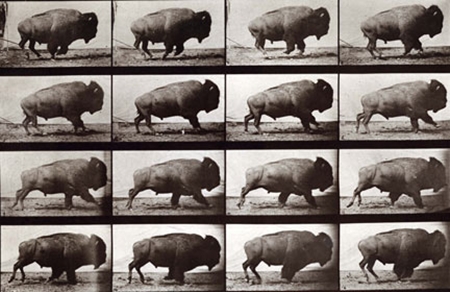Photography can certainly bring out some of the real characters in this world. I was reminded of this the other day when Mr. Google had several shots in sequence of a horse galloping by. This was the work of one very weird photographer, Edweard Muybridge who was one of the ‘characters’ in the history of photography. However, while decidedly eccentric he did further scientific knowledge and in fact made the first cinema projector, so should be remembered fondly.
Edweard Muybridge was actually born plain Edward Muggeridge in the UK in 1830 but emigrated to America in the early 1850’s and changed his name (as did a lot of other people emigrating in those days – and even these days to places like Pattaya). Edward’s reasons for emigration were not stated.
 Muybridge’s bison on the hoof.
Muybridge’s bison on the hoof.
In the 1860’s he took up photography and gained some fame as a topographical photographer and even published a book, “Scenery of the Yosemite Valley” in 1867, so Ansel Adams was not the only one to see the possibilities in the majestic landscapes.
However, it was the photography of motion that attracted Edweard. In 1872 he finally managed to successfully photograph a horse in motion showing that at certain times all four hooves are off the ground simultaneously, this fact being one of much controversy and wagers. Unfortunately, immediately after proving his point, he was tried for murdering his wife’s lover – but was acquitted. He was then sued for divorce by the distraught lady and finally widowed. All this kept Edweard away from his photography of motion for four years.
Returning to photography, with the millionaire railroad builder, Leland Stanford as his sponsor, Edweard developed a unique system in 1878 which was in reality 12 cameras mounted side by side and operated by trip wires. By the following year he had expanded this to 24 cameras and could thus take very short time interval photographs of horses, dogs, pigeons and goats in motion. This in turn led to photographing moving humans, despite enormous problems in getting people to walk past his battery of 24 cameras in the nude! However, by 1881 he published these in a book.
His next objective was to show these as motion and he invented the “Zoopraxiscope” which projected sequences of these photographs mounted on a glass disc to give the impression of true motion. This was in fact the worlds first cinema projector and preceded Thomas Edison’s “Kinetoscope” by some twelve years.
In 1882 Edweard went to Europe, hopeful of raising sponsorship to continue his photographic study of movement, but returned to America with empty pockets. He was then lucky enough to get backing from the University of Pennsylvania. They kept him alive while he photographed 2000 models, male and female, clothed and nude, as well as wild animals. When he ran out of models, he even used himself, taking his serial shots of himself walking up and down ramps. 20,000 photographs of almost 800 different subjects were published in a book called “Animal Locomotion” in 1887.
Once again, he was to run out of money for his grandiose schemes and tried selling the “Animal Locomotion” book at $100 a book. Needless to say it was not an overnight best seller.
This led our Edweard to new heights. He built a hall to demonstrate the Zoopraxiscope, called the Zoopraxographical Hall in the 1893 Chicago World’s Colombian Exhibition. This was the world’s first movie theatre and predated the Lumiere brothers “Cinematographe” presentations by three years.
Despite his inventiveness, the world did not beat a path to his studio and Edweard decided he had enough of this photography lark, returning to the UK, where he bequeathed all his photographic equipment to the local library. At the turn of the century he reprinted his original books, earning enough to eke out his last four years of life.
Of course, what Edweard did not realize was that almost 100 years later the scientific community would find that he had left them the most complete records of animal motion ever produced and in fact in 1979 his books were republished. It’s a (ed)weird world we live in!




